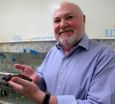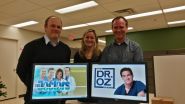INFORMATION:
Concerns raised about variable performance of some UK personal use breathalyzers
Ability of devices to detect potentially unsafe alcohol levels prompts questions about regulatory process
2014-12-20
(Press-News.org) The ability of some breathalyzers widely sold to the UK public to detect potentially unsafe levels of breath alcohol for driving, varies considerably, reveals research published in the online journal BMJ Open.
The findings call into question the regulatory process for approving these sorts of devices for personal use, say the researchers, particularly as false reassurance about a person's safety to drive could have potentially catastrophic consequences.
The researchers compared the diagnostic accuracy (sensitivity) of three personal use breathalysers to detect alcohol levels at or over the UK legal limit in 208 adults, who were drinking in college bars and pubs in the centre of Oxford, England, in late 2012 and early 2013.
At least 20 minutes after drinking, participants were asked to test the single use Alcosense Single (100 people) or the comparable Dräger Alco-check (108 people), as well as the digital multi-use Alcosense Elite, one minute apart, in random order.
These devices are widely available in leading pharmacies and other major retailers, as well as online.
The participants, whose average age was 20, estimated that they had drunk an average of 6 units of alcohol (46 g) that evening, ranging from 1 to 25 units (8-204 g).
The readings from the three devices were compared with those obtained from a Dräger Alcotest 6510 device, which is used by the police to check drivers' legal alcohol limits at the roadside.
The legal limit for driving in the UK is 35 ug/100 ml of breath alcohol, and almost one in five (18%; 35) of those tested were at or over this limit, when the police breathalyser was used.
Compared with the police breathalyser, the digital Alcosense Elite had a sensitivity of around 90%, while the Dräger AlcoCheck had a sensitivity of just under 95%, in the main analysis.
But even a sensitivity of 95% means that around 1 in 20 people over the legal driving limit for alcohol would be falsely reassured, say the authors: "We question whether even this would be sufficient sensitivity to assess safety to drive," they write.
And the Alcosense Single had an even lower sensitivity of only 26%, compared with the police breathalyser, meaning that the device would pick up only around one in four people over the legal limit, shortly after drinking.
And when participants, rather than the researchers, interpreted the results of this device, the sensitivity fell further to 17%.
The researchers acknowledge that the study has limitations. For example, the manufacturers of the Alcosense Elite stipulate that it should be used 30 minutes after drinking, when it was used 20 minutes afterwards in this study, so this may have affected the results for this breathalyser.
And the profile of the drinkers in the study may not be typical of those who are likely to buy breathalysers for personal use, they add. Similarly, the researchers didn't test the accuracy of the devices when used the day after drinking.
But they say: "Our research suggests that at least some personal breathalysers available for sale to the public are not always sufficiently sensitive to test safety to drive after drinking alcohol, where use of inaccurate information from breathalysers, thought to be accurate, could have catastrophic safety implications for drivers."
They add: "The fact that these devices are sold in well-established pharmacies, including national chains, does not guarantee sufficient accuracy for safe use."
Furthermore, regulatory approval, signified by the CE or NF markings, doesn't appear to have anything to do with accuracy, raising wider questions about how these markings may be perceived by consumers, they point out.
"Our research raises worrying questions about the level of scrutiny that medical tests intended for sale to the public undergo in Europe, and raises wider concerns about how diagnostic accuracy, in particular, is evaluated," they conclude.
ELSE PRESS RELEASES FROM THIS DATE:
Research shows E.B. White was right in 'Charlotte's Web'
2014-12-19
Before Charlotte the spider spelled the word "humble" in her web to describe Wilbur the pig, she told Templeton the rat that the word meant "not proud."
That's probably what most people say if you put them on the spot. But if you give them time to think about it deeply, like a new study just did, other themes emerge that have a lot to do with learning.
And these intellectual dimensions of humility describe the spider as well or better than the pig.
"Wilbur has many of the dimensions of humility in general: regard for others, not thinking too highly of himself - but ...
NASA's SDO captures images of 2 mid-level flares
2014-12-19
The sun emitted a mid-level flare on Dec. 18, 2014, at 4:58 p.m. EST. NASA's Solar Dynamics Observatory, which watches the sun constantly, captured an image of the event. Solar flares are powerful bursts of radiation. Harmful radiation from a flare cannot pass through Earth's atmosphere to physically affect humans on the ground, however -- when intense enough -- they can disturb the atmosphere in the layer where GPS and communications signals travel.
To see how this event may affect Earth, please visit NOAA's Space Weather Prediction Center at http://spaceweather.gov, ...
Lost memories might be able to be restored, new UCLA study indicates
2014-12-19
New UCLA research indicates that lost memories can be restored. The findings offer some hope for patients in the early stages of Alzheimer's disease.
For decades, most neuroscientists have believed that memories are stored at the synapses -- the connections between brain cells, or neurons -- which are destroyed by Alzheimer's disease. The new study provides evidence contradicting the idea that long-term memory is stored at synapses.
"Long-term memory is not stored at the synapse," said David Glanzman, a senior author of the study, and a UCLA professor of integrative ...
Alaska fish adjust to climate change by following the food
2014-12-19
Not all species may suffer from climate change. A new analysis shows that Dolly Varden, a species of char common in southeast Alaska, adjust their migrations so they can keep feasting on a key food source - salmon eggs - even as shifts in climate altered the timing of salmon spawning.
The resiliency of species to climate change may depend on how well they adapt to climate-driven changes in their food and habitat, such as altered growth of plants they feed on. A mismatch in timing between predators and the availability of prey could cause some species to lose access to ...
Early exposure to antidepressants affects adult anxiety and serotonin transmission
2014-12-19
About 15 percent of women in the United States suffer from anxiety disorders and depression during their pregnancies, and many are prescribed antidepressants. However little is known about how early exposure to these medications might affect their offspring as they mature into adults.
The answer to that question is vital, as 5 percent of all babies born in the U.S. - more than 200,000 a year - are exposed to antidepressants during gestation via transmission from their mothers.
Now, a UCLA team has studied early developmental exposure to two different antidepressants, ...
Atom-thick CCD could capture images
2014-12-19
HOUSTON - (Dec. 19, 2014) - An atomically thin material developed at Rice University may lead to the thinnest-ever imaging platform.
Synthetic two-dimensional materials based on metal chalcogenide compounds could be the basis for superthin devices, according to Rice researchers. One such material, molybdenum disulfide, is being widely studied for its light-detecting properties, but copper indium selenide (CIS) also shows extraordinary promise.
Sidong Lei, a graduate student in the Rice lab of materials scientist Pulickel Ajayan, synthesized CIS, a single-layer matrix ...
New technique reveals immune cell motion
2014-12-19
PROVIDENCE, R.I. [Brown University] -- Neutrophils, a type of white blood cell, are the immune system's all-terrain vehicles. The cells are recruited to fight infections or injury in any tissue or organ in the body despite differences in the cellular and biochemical composition. Researchers from Brown University's School of Engineering and the Department of Surgery in the Warren Alpert Medical School collaborated to devise a new technique for understanding how neutrophils move in these confined spaces.
The technique involves two hydrogel sacks sandwiched together with ...
A polymorphism and the bacteria inside of us help dictate inflammation, antitumor activity
2014-12-19
PHILADELPHIA - (Dec. 19, 2014) - A common polymorphism - a variation in a person's DNA sequence that is found with regularity in the general population - can lead to a chain of events that dictates how a tumor will progress in certain types of cancer, including a form of breast cancer as well as ovarian cancer, according to new research from The Wistar Institute that was published online by the journal Cancer Cell.
The research reveals a more explicit role about the symbiotic relationship humans have with the various bacteria that inhabit our body and their role during ...
Televised medical talk shows: Health education or entertainment?
2014-12-19
(Edmonton) For millions of people around the world, televised medical talk shows have become a daily viewing ritual. Programs such as The Dr. Oz Show and The Doctors have attracted massive followings as charismatic hosts discuss new medical research and therapies while offering viewers their own recommendations for better health. For show producers it's a winning ratings formula, but for viewers eager for a healthier life, the results aren't so clear cut.
"The research supporting any of these recommendations is frequently absent, contradictory or of poor quality," says ...
Family criticizing your weight? You might add more pounds
2014-12-19
Women whose loved ones are critical of their weight tend to put on even more pounds, says a new study on the way people's comments affect our health.
Professor Christine Logel from Renison University College at the University of Waterloo led the study, which appears in the December issue of the journal Personal Relationships.
"When we feel bad about our bodies, we often turn to loved ones--families, friends and romantic partners--for support and advice. How they respond can have a bigger effect than we might think," said Professor Logel, who teaches social development ...
LAST 30 PRESS RELEASES:
Puzzling link between depression and cardiovascular disease explained at last: they partly develop from the same gene module
Synthetic droplets cause a stir in the primordial soup
Future parents more likely to get RSV vaccine when pregnant if aware that RSV can be a serious illness in infants
Microbiota enterotoxigenic Bacteroides fragilis-secreted BFT-1 promotes breast cancer cell stemness and chemoresistance through its functional receptor NOD1
The Lundquist Institute receives $2.6 million grant from U.S. Army Medical Research Acquisition Activity to develop wearable biosensors
Understanding the cellular mechanisms of obesity-induced inflammation and metabolic dysfunction
Study highlights increased risk of second cancers among breast cancer survivors
International DNA Day launch for Hong Kong’s Moonshot for Biology
New scientific resources map food components to improve human and environmental health
Mass General Brigham research identifies pitfalls and opportunities for generative artificial intelligence in patient messaging systems
Opioids during pregnancy not linked to substantially increased risk of psychiatric disorders in children
Universities and schools urged to ban alcohol industry-backed health advice
From Uber ratings to credit scores: What’s lost in a society that counts and sorts everything?
Political ‘color’ affects pollution control spending in the US
Managing meandering waterways in a changing world
Expert sounds alarm as mosquito-borne diseases becoming a global phenomenon in a warmer more populated world
Climate change is multiplying the threat caused by antimicrobial resistance
UK/German study - COVID-19 vaccine effectiveness and fewer common side-effects most important factors in whether adults choose to get vaccinated
New ultraviolet light air disinfection technology could help protect against healthcare infections and even the next pandemic
Major genetic meta-analysis reveals how antibiotic resistance in babies varies according to mode of birth, prematurity, and where they live
Q&A: How TikTok’s ‘black box’ algorithm and design shape user behavior
American Academy of Arts and Sciences elects three NYU faculty as 2024 fellows
A closed-loop drug-delivery system could improve chemotherapy
MIT scientists tune the entanglement structure in an array of qubits
Geologists discover rocks with the oldest evidence yet of Earth’s magnetic field
It’s easier now to treat opioid addiction with medication -- but use has changed little
Researchers publish final results of key clinical trial for gene therapy for sickle cell disease
Identifying proteins causally related to COVID-19, healthspan and lifespan
New study reveals how AI can enhance flexibility, efficiency for customer service centers
UT School of Natural Resources team receives grant to remove ‘forever chemicals’ from water
[Press-News.org] Concerns raised about variable performance of some UK personal use breathalyzersAbility of devices to detect potentially unsafe alcohol levels prompts questions about regulatory process






